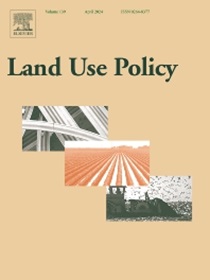Enhancing natural habitats conservation success on private lands by understanding and addressing deficiencies in social capital
IF 5.9
1区 社会学
Q1 ENVIRONMENTAL STUDIES
引用次数: 0
Abstract
Over the last decades, biodiversity conservation in Quebec province, Canada, has evolved from an ecology-centered discipline, mostly focused on ecosystem protection on public lands (e.g., protected areas and reserves), to an interdisciplinary field with increasing participatory efforts deployed to preserve private lands' habitats. Yet, conservation on private lands has experienced mixed results, notably because of limits regarding the creation of positive relationships to support community capacity to conserve through landowner engagement. It has proven difficult to integrate social knowledge and realities in the governance of conservation and to act on social-ecological issues to reach conservation objectives. In this paper, we study how social relationships shape conservation governance, and we illustrate the opportunities that these relationships offer and the limits that they impose. To do so, we explore social representations of social issues in conservation as perceived by actors and expressed during three participative workshops, carried out with a diverse array of actors in 2019 and 2020. We analyze our data through the concept of social capital to depict relationships through four dimensions (structural, functional, relational, cognitive). We find that social capital that supports landowner engagement and community capacity to conserve suffers from four forms of deficiencies. These are negative social capital, diverging social representations, dissociated social capital dimensions and sub-optimized social capital. These deficiencies are most prominent in relationships that link local actors to the provincial government, followed by relationships between municipal actors and other regional actors. We argue that bracing social capital through efforts that tackle all four dimensions at once might be the key to enhancing social connectivity in conservation governance. We conclude by identifying three broad needs for bracing social capital to improve conservation governance on private lands. These are 1) growing a shared understanding of conservation challenges through improved communication venues, 2) establishing feedback systems between local actors and decision-makers to encourage reciprocity in relationships, and 3) developing systemic knowledge to better inform conservation actions and avoid false solutions.
通过了解和解决社会资本不足的问题,提高私人土地自然生境保护的成功率
在过去的几十年里,加拿大魁北克省的生物多样性保护已经从一个以生态学为中心的学科,主要关注公共土地(如保护区和保护区)的生态系统保护,发展成为一个跨学科的领域,越来越多的人参与到保护私人土地的栖息地中来。然而,私人土地保护的结果好坏参半,主要是因为在建立积极关系以支持社区通过土地所有者参与保护的能力方面存在限制。事实证明,很难将社会知识和现实结合到保护管理中,并就社会生态问题采取行动以实现保护目标。在本文中,我们研究了社会关系如何影响保护治理,并说明了这些关系提供的机会和它们施加的限制。为此,我们在2019年和2020年与各种各样的行动者一起举办的三次参与性研讨会上,探讨了行动者对保护中社会问题的社会表征。我们通过社会资本的概念来分析我们的数据,通过四个维度(结构、功能、关系、认知)来描述关系。我们发现,支持土地所有者参与和社区保护能力的社会资本存在四种形式的缺陷。负向社会资本、分化的社会表征、分离的社会资本维度和次优化的社会资本。这些缺陷在地方行为体与省政府之间的关系中最为突出,其次是市政行为体与其他区域行为体之间的关系。我们认为,通过同时解决所有四个维度的努力来支撑社会资本,可能是加强保护治理中社会联系的关键。最后,我们确定了支持社会资本以改善私人土地保护治理的三个广泛需求。这些挑战包括:1)通过改善交流场所,加深对保护挑战的共同理解;2)在地方行动者和决策者之间建立反馈系统,鼓励关系中的互惠;3)发展系统知识,更好地为保护行动提供信息,避免错误的解决方案。
本文章由计算机程序翻译,如有差异,请以英文原文为准。
求助全文
约1分钟内获得全文
求助全文
来源期刊

Land Use Policy
ENVIRONMENTAL STUDIES-
CiteScore
13.70
自引率
8.50%
发文量
553
期刊介绍:
Land Use Policy is an international and interdisciplinary journal concerned with the social, economic, political, legal, physical and planning aspects of urban and rural land use.
Land Use Policy examines issues in geography, agriculture, forestry, irrigation, environmental conservation, housing, urban development and transport in both developed and developing countries through major refereed articles and shorter viewpoint pieces.
 求助内容:
求助内容: 应助结果提醒方式:
应助结果提醒方式:


